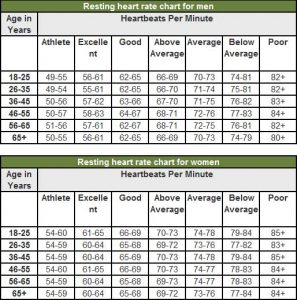Resting Heart Rate Chart
Here are healthy ranges of resting heart rate depending on age.

Factors That Can Influence Resting Heart Rate
Some factors can significantly contribute to lower or higher heart rate such as fitness and activity level, body position, air temperature, stress, and emotions level, medications, body size, illness, food, and drink.
To measure your resting heart rate accurately, you should be at complete rest. When measured during some activity, the resting heart rate will be higher and you may think that your heart is at risk.
How to Measure the Resting Heart Rate?
First of all, make sure you are comfortable and relaxed. So, sit or lie motionless for 5 to 10 minutes. Then, with your index and middle fingers locate your pulse on the inside of your wrist. This is the point where the radial artery is found.
For 10 seconds, count the beats you feel. Make sure your repeat this test 2-3 times to find your average number. Then multiply that particular number by six. (E.g. 10×6=60)
Tips for Healthier Resting Heart Rate
You can improve your resting heart rate in the following way:
Exercise regularly
Reduce the level of stress
Quit smoking
Keep a healthy weight
Reduce the intake of caffeine
Get good quality of sleep
By maintaining a lower resting heart rate, you will reduce the risk of some heart-related diseases and improve its function.
Source Bel Marra Health | Health Harvard
Image Source Online Clock